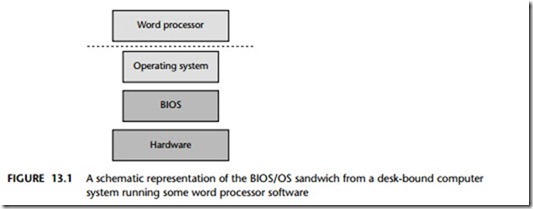The desktop OS
As stated in the preface, it is assumed in this book that readers will have had previous experience of software development for desktop computer systems. As we discussed in Chapter 1, the desktop / workstation environment plays host to many information sys- tems, as well as general-purpose desktop applications, such as word processors. A common characteristic of modern desktop environments is that the user interacts with the application through a high-resolution graphics screen, plus a keyboard and a mouse. Support for this complex user interface is provided by the operating system and its associated libraries.
In such an environment, the program the user requires (such as a word processor) is usually loaded from disk on demand, along with any required data (such as a word processor file). Figure 13.1 shows a typical operating environment for such a word processor. Here the application is well insulated from the underlying hardware. For example, when the user wished to save her latest novel on disk, the word processor del- egates most of the necessary work to the operating system, which in turn may delegate many of the hardware-specific commands to the BIOS (basic input/output system).
The desktop PC does not require an operating system (or BIOS). However, for most users, the main advantage of a personal computer is its flexibility: that is, that the same piece of equipment has the potential to run many thousands of different programs. If the PC had no operating system, each of these programs would need to be able to carry out all the low-level functions for itself. This would be very inefficient and would tend to make applications more expensive. It would also be likely to lead to errors, as many functions would have to be duplicated in even the smallest of programs.
We can get a feel for the type of problems that would result in a world without Windows (or UNIX) if we consider ‘DOS’, an early operating system widely used on PCs. Readers old enough to have used DOS applications will remember that every program needed to provide a suitable printer driver: if the printer was subsequently changed, this generally meant that every application on the PC needed to be upgraded in order to take advantage of the new hardware. With Windows, this problem does not arise: when a new printer is purchased, a single driver is required. When this had been installed, every program on the computer can immediately make use of the new hardware.
One way of viewing this is that a desktop operating system is used to run multiple programs, and the operating systems provides the ‘common code’ (for printing, file storage, graphics, and so forth) that is required by this set of programs: this reduces the need to duplicate identical program components, reducing the opportunity for errors and making the overall system more reliable and easier to maintain.

